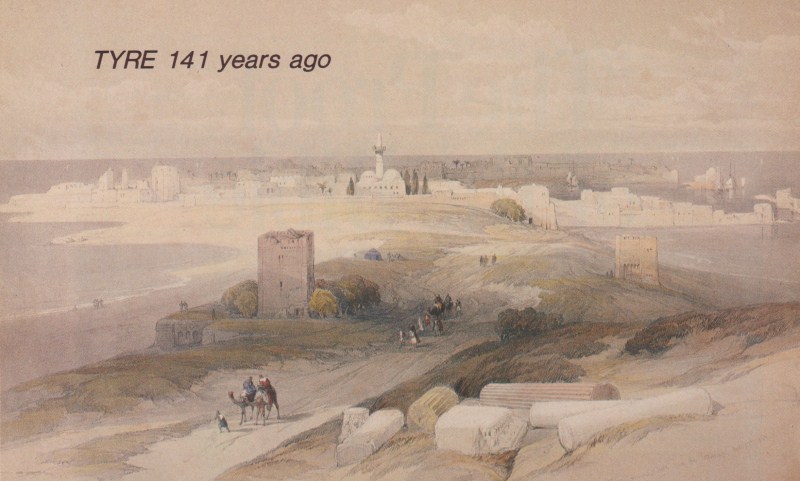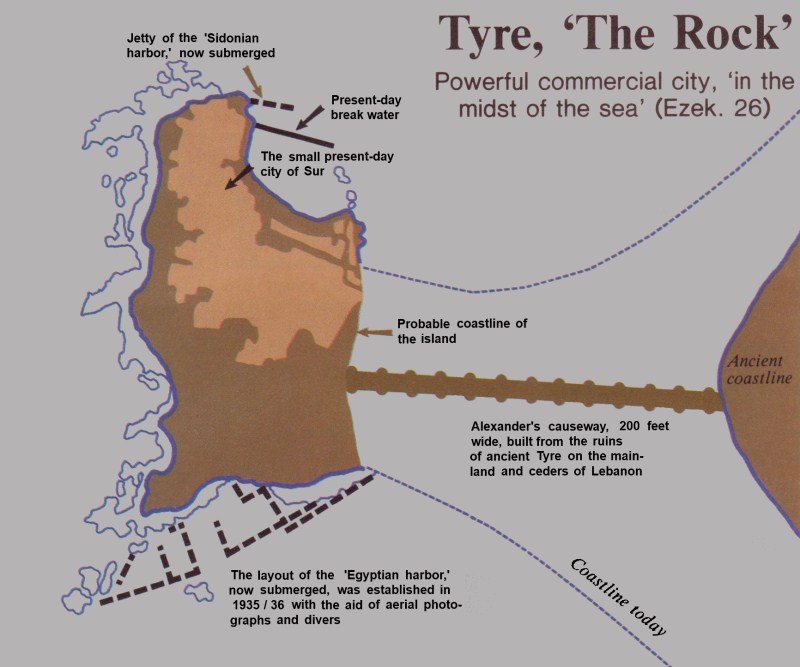Here is clarification on a long misunderstood point.
In the early years of Ambassador College we all read an intriguing booklet challenging the agnostic and the atheist. It was titled Prophecy Speaks! In it the author quoted Ezekiel's prophecy — actually, God's prophetic warning — concerning Tyre, the famous port-city of the Phoenicians. The author dared his doubting readers to face the challenge of Ezekiel 26:14:
"And I will make thee like the topof a rock: thou shalt be a place to spread nets upon; thou shalt be built no more: for I the Lord have spoken it, saith the Lord God."
Here, declared the author, is God's challenge to the atheist. Try to rebuild ancient Tyre! Dare to defy God's Word, which said of this city, "Thou shalt be built no more."
It did seem quite a challenge. It was a time when people were interested in proving the Bible — incontrast to the self-centered "me generation," interested only in its own personal problems. We looked into the author's claims. Some of his historical interpretation about Tyre was inaccurate, as anyone reading the encyclopedias could readily see. We visited the site of Tyre in Lebanon to acquaint ourselves better with the facts. Still, the author's claim that this prophecy was a challenge to the skeptic today seemed very real.
 |
 |
A beautiful hand-colored black-and-white lithograph by Louis Haghe of the site of Tyre, modern Sur, based on a drawing by David Roberts, as he saw the city on April 24, 1839. Roberts drew this view from the isthmus now linking Sur, the island city, to the mainland. The Sidonian port on the north is still used for coastal shipping. Sur, the Arabic city of Tyre, overlies, in part, the Crusader, the Roman and the Phoenician cities, each rebuilt after the ravages of war. Modern archaeological techniques make clear the intent of Ezekiel's prophecy, long misunderstood by Bible students.
And so for years we assumed that Ezekiel 26:14 was a prophecy already fulfilled — a living challenge to the atheist and skeptic. That is what I thought, when visiting the site of Tyre in the summer of 1957 with Dr. C. Paul Meredith.
But I was wrong.
I presupposed the prophecy already to have been fulfilled. After all, Adam Clarke, in his commentary, assured his readers that the Chaldean king Nebuchadnezzar destroyed Old Tyre on the mainland and it was "never rebuilt." And the island city with its ports was demolished by the Mamelukes from Egypt in A.D. 1291.
The truth is, Adam Clarke was wrong. And so was the author of that booklet Prophecy Speaks! published by the Seventh-day Adventists. Ezekiel 26:14 will not be completely fulfilled until the return of Jesus Christ to reestablish the government of God on earth and to begin to save the world as a whole. Verse 20 makes it plain that Tyre will not finally be uninhabited until the time when God says, "I shall set glory in the land of the living" — which will occur when Jesus Christ returns in divine glory.
It is at that time that Jesus will command: "And they shall build the old wastes, they shall raise up the former desolations, and they shall repair the waste cities, the desolations of many generations" (Isa. 61:4; 58:12). But not Tyre! Of it God says, "And I will make thee like the top of a rock: thou shalt be a place to spread nets upon; thou shalt be built no more: for I the Lord have spoken it."
That is when this prophecy of Ezekiel will be enforced.
Now consider the evidence of history.
Archaeologists have only begun to scratch the surface at Tyre. See the February, 1970, and the August, 1974, issues of National Geographic. But the records of history are sufficient to make the history of Tyre plain. Tyre (Hebrew: Sor) was already an important Phoenician city in the 15th century B.C. Joshua 19:29 refers to it as "the fortified city of Tyre" (Revised Standard Version). It is mentioned again in II Samuel 24:7 as a fortress in the days of David.
Between these two periods of time the Egyptians make reference to Tyre's important geographic situation. An Egyptian school text of the period of the judges in Israel reads: "Pray, instruct me about Beirut, about Sidon and Sarepta. . . . They say another town is in the sea, named Tyre-the-Port" (John A. Wilson, "An Egyptian Letter," Papyrus Anastasi I, ANET, p. 477). Tyre was a dual city. Part lay on the coast, part offshore on islands of rock.
Skipping over the numerous biblical references to Tyre in the days of Solomon and the later kings of Israel and Assyria, we come to the time of Nebuchadnezzar. God revealed to Ezekiel in the year that Jerusalem fell that He would bring upon Tyre (Tyrus) Nebuchadnezzar king of Babylon "from the north, with horses, and with chariots, and with horsemen, and companies, and much people. . . . And he shall set engines of war against thy walls, and with his axes he shall break down thy towers . . . thy walls shall shake at the noise of the horsemen, and of the wheels, and of the chariots, when he shall enter into thy gates . . . and thy strong garrisons shall go down to the ground" (Ezek. 26:7-11).
Verse 11 ends the prophecy about Nebuchadnezzar's siege. Up to this point the singular forms "he" and "his" are exclusively used to refer to the king of Babylon. Suddenly the prophecy shifts to "they" in verse 12: "And they shall make a spoil of thy riches, and make a prey of thy merchandise: and they shall break down thy walls . . . and they shall lay thy stones and thy timber and thy dust in the midst of the water."
Why this sudden change in pronouns? Because Nebuchadnezzar did not fulfill this verse — but others did, years later. The king of Babylon did not make a spoil of Tyre's riches. See Ezekiel 29:17-20. The king had an immense army of horsemen and foot soldiers, but he had no fleet. He could not besiege the walled part of the city that lay on the rock offshore. During the siege the Phoenicians transported their wealth from the mainland to the offshore island fortress. When the mainland part of the city (Old Tyre) fell to the king, the defenders were slaughtered. But there was no wealth to capture (verse 18).
Yet God revealed to Ezekiel that Tyre's wealth would become a spoil (Ezek. 26:12). The prophecy was not to be fulfilled all in one generation!
In the years following Nebuchadnezzar's empty victory, the site of Old Tyre (Paleotyrus) was rebuilt — contrary to Adam Clarke and the author of Prophecy Speaks! Its old walls were not restored, but it became a significant open city, extending along the shore. This was not at all clear to us when we visited Tyre in 1957.
When Alexander, the king of Macedonia, reached the Phoenician coast in 332 B.C., in his conquest of the Persian empire, he appeared before the nobles of Tyre on the mainland. Alexander requested permission to sacrifice to the Tyrian god Heracles, from whom he claimed descent. At that time there were two temples of Heracles at Tyre, one on the mainland and one on the island fortress (Quintus Curtius 4.2.4). This fact we overlooked for years. The Tyrians offered the Macedonian king the temple on the mainland at Old Tyre for his sacrifice. The king was insulted and demanded to enter the island city or he would besiege it!
The rest is history. Alexander built from the quickly abandoned mainland town a mole linking the mainland to the island. He took the masonry and large stones, the timber and the very dust of Old Tyre and laid them in the sea to form the mole. New Tyre, on the island, fell. Its riches were captured. And the mole became a peninsula as the sands washed against it over the centuries.
Both Old Tyre and New Tyre were resettled. By the time of Jesus the city Tyre had again become a thriving port (Mark 7:24-31). It is referred to in Acts 12:20-21, during the reign of Herod. Pliny, a Roman scholar, visited Tyre in the days of the apostles and recorded its size. He computed the circuit of mainland Tyre and the island at 19 Roman miles and the circumference of the island proper at slightly less than 3 miles (Pliny, Natural History, 5.17.76).
But what of the prophecy that Tyre would not be rebuilt?
Look again at Ezekiel 26. Remember, verses 7 to 11 use the singular pronoun to refer to Nebuchadnezzar. Suddenly, verse 12 uses the plural pronoun "they" to refer to Alexander and numerous other generals who came after him and plundered Tyre — Greeks, Romans, Arabs, the Crusaders, the Mamelukes. Ezekiel 26:3 quotes God as saying that He "will cause many nations to come up against thee [Tyre], as the sea causeth his waves to come up." That is precisely what has happened through history. One nation after another has come against Tyre. "They" made a spoil of Tyre's riches.
The Mamelukes, after taking the city from the Crusaders near the close of the 13th century, dismantled the city so it would not again be used as a fort by so-called Christian Crusaders from Europe against Islam.
In the next century Sir John Maundeville traveled from Cyprus to Jerusalem by way of Tyre. He wrote of his experience: "In a day and night he that hath good wind may come to the haven of Tyre, which is now called Sur. [This is the Arabic word for Tyre and means "rock."] Here was once a great and good city of the Christians, but the Saracens have destroyed it in great part, and they guard that haven carefully for fear of the Christians" ("The Book of Sir John Maundeville, A.D. 1322-1356" in Thomas Wright, Early Travels in Palestine, p. 141).
A similar indication of the life of the Moslem town is given by Bertrandon de La Brocquiere, one of the last medieval travelers, in 1432 (Early Travels in Palestine, pp. 282-283).
Tyre continued to sink into obscurity until the Metualis occupied the district in 1766. It once again grew to a few thousand inhabitants. With the coming of the state of Israel, Tyre rapidly expanded to accommodate those Islamic Arabs who fled Palestine and settled in southern Lebanon.
And that is where we are today in history. Tyre is still inhabited, still a minor port. Its wealth is gone.
But Ezekiel 26:13-14 reveals something yet to happen: "And I" — no longer "they," but "I" — "will cause the noise of thy songs [they are Arabic songs today] to cease; and the sound of thy harps shall be no more heard. And I" — not "they" — "will make thee like the top of a rock: thou shalt be a place to spread nets upon; thou shalt be built no more: for I the Lord have spoken it . . ."
This is God's doing. He will cause the waters of the Mediterranean to wash over the site of Tyre till the accumulated millennia of rubble are washed away, and it is suitable only for the spreading of nets between tides. This has never fully happened. Oh yes, a small part of New Tyre on its western edge is under water. We saw it clearly in 1957. But the major part of the Phoenician city is covered by sand and the accumulated rubble of later buildings, roads and burial grounds. A significant part lies today beneath the modern Arab town.
This prophecy, much misunderstood, is not the challenge to the skeptic we assumed. It is a prophecy yet to be fulfilled by Jesus Christ when He brings peace to the world!